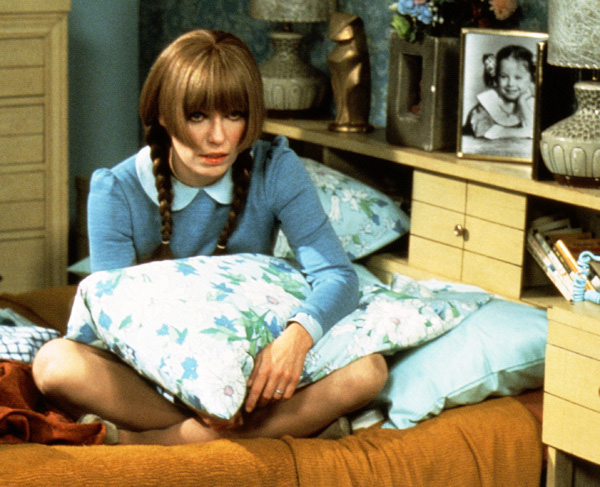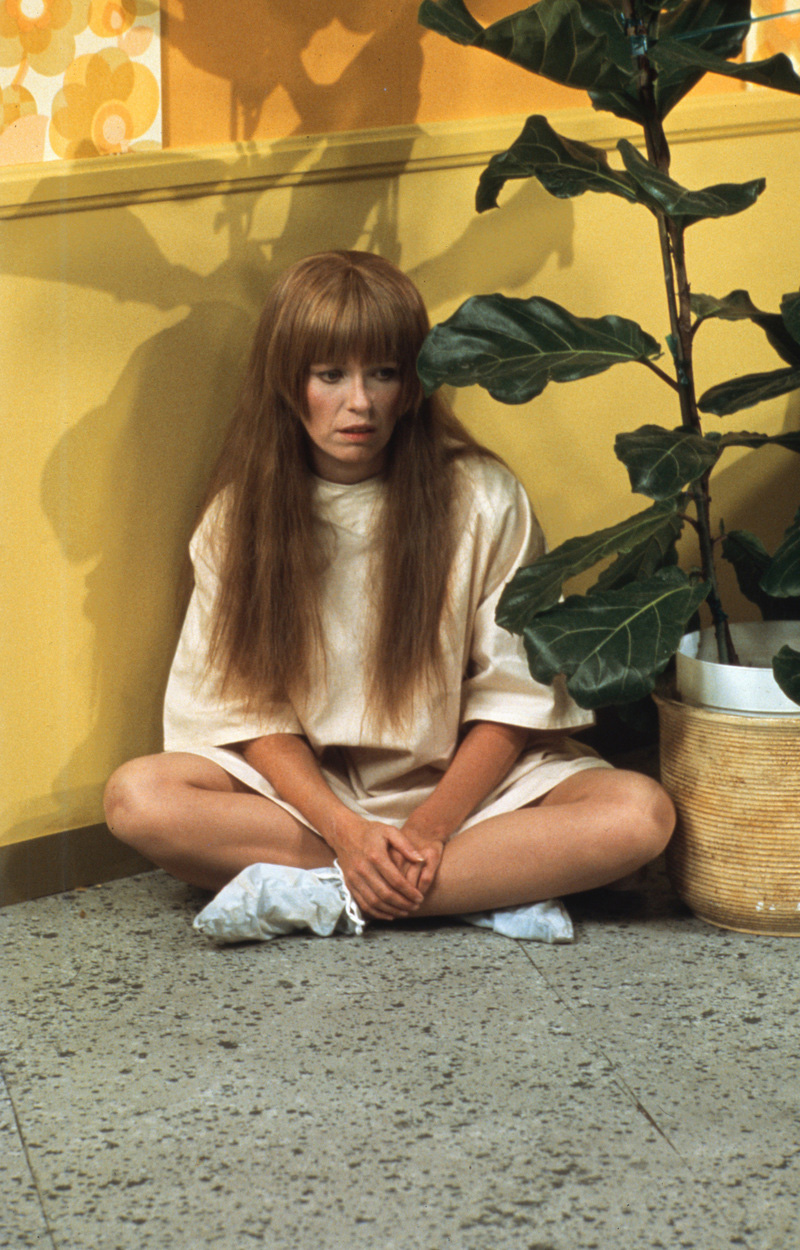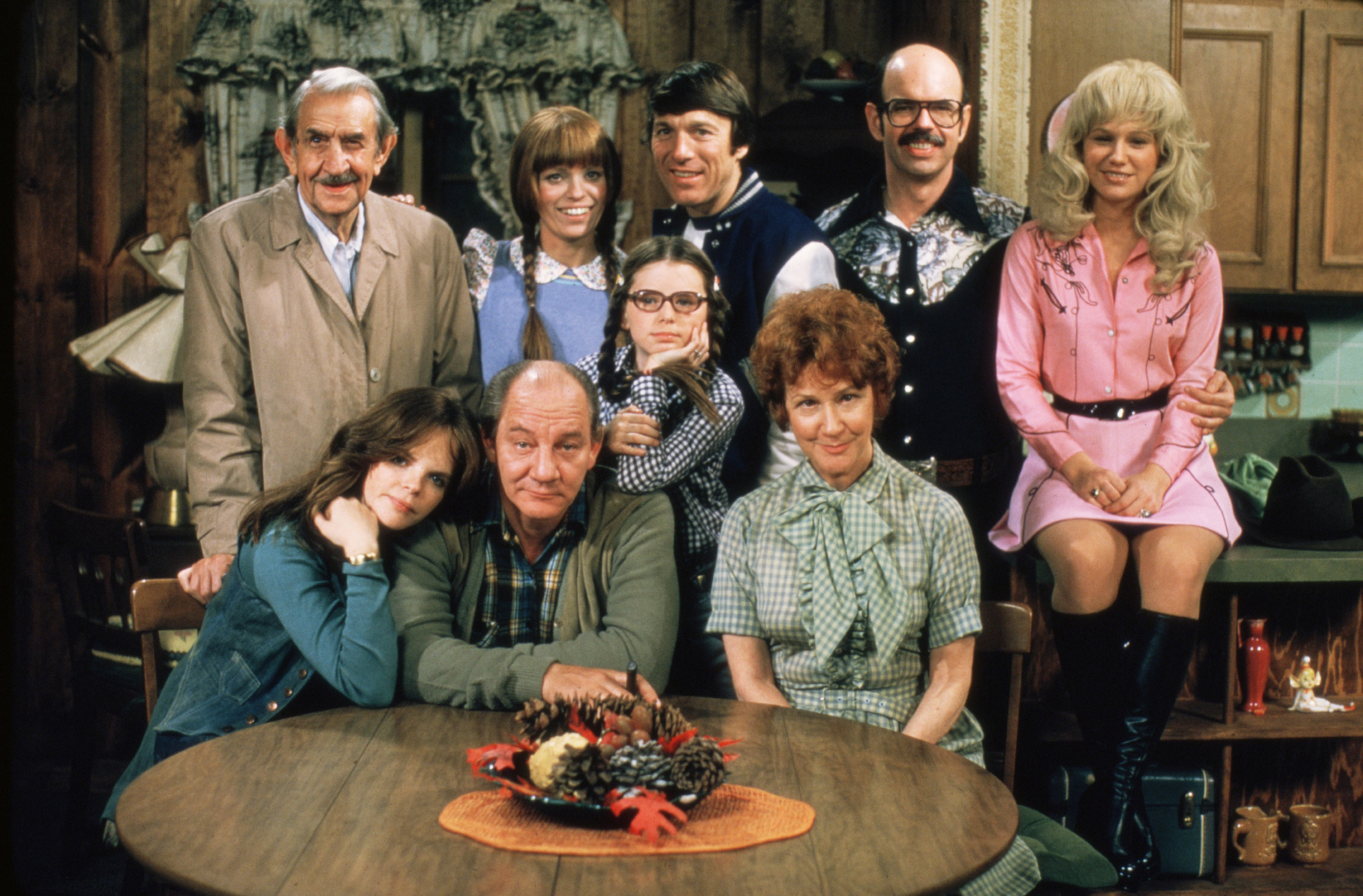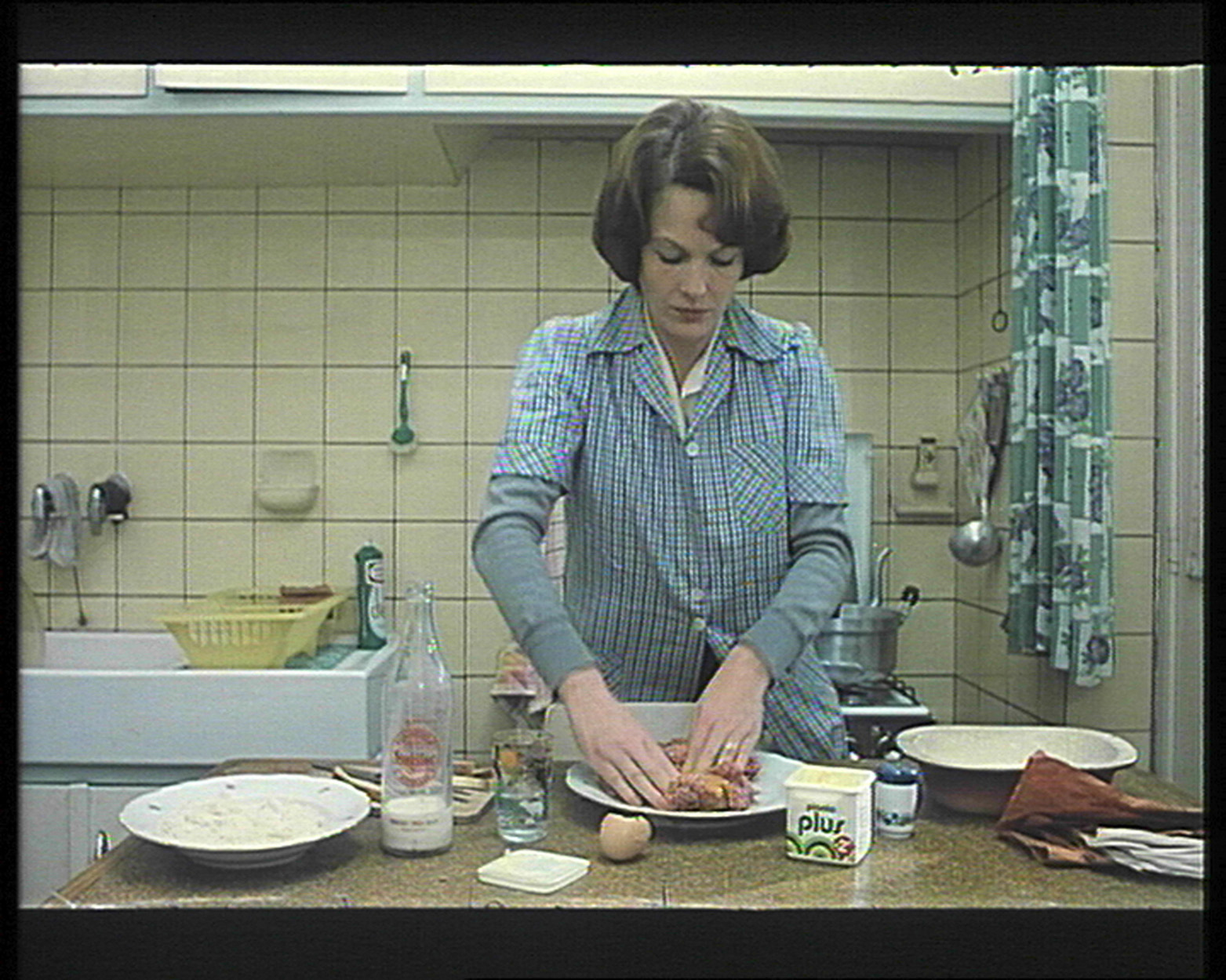From a Waxy Yellow Buildup to a Nervous Breakdown: The Fleeting Existence of Mary Hartman, Mary Hartman
by Claire Barliant

Still from Mary Hartman, Mary Hartman. Louise Lasser (Mary Hartman). Copyright CPT Holdings, Inc. All Rights Reserved. (Sony Pictures Television International).
McLuhan missed it: We’re not a global village, we’re a global OUTPATIENT CLINIC, and the life force itself is most fully embodied in a frenetically twitching nerve. —Lester Bangs1
The nervous breakdown peaked circa 1975. The epidemic reached, or maybe started in, the White House: Nixon is said to have suffered one in office; Betty Ford soon followed. This pervasively twitchy mood was captured in a performance by Louise Lasser, who, in the role of beleaguered housewife Mary Hartman on the television soap opera Mary Hartman, Mary Hartman, freaks out during an appearance on a nationally televised talk show. In the episode, which aired toward the end of the series’ first season, in 1976, three pundits—a feminist, a media critic, and a consumer advocate—interview Hartman, who appears on The David Susskind Show as “America’s typical consumer housewife.” When the pundits start grilling her on her sex life and whether she feels “fulfilled,” she begins to panic. She stutters, leans over to whisper to the talk show host that she had expected to talk about her favorite household products, and then, flummoxed by the barrage of questions, unintentionally divulges that her husband is impotent. At this point, in an almost too-painful-to-watch climax, she turns to face the camera, makes a wiping motion with her hand, and then, in a flat, atonal way, using the kind of voice you might use if you were addressing a voice-operated machine, says, “Erase. Erase.”2
Mary Hartman, Mary Hartman ran for only two seasons, from 1976 to 1977. When it was originally broadcast, it was a nationwide phenomenon. Louise Lasser appeared on the covers of Rolling Stone and People magazines, and costar Mary Kay Place (who played an aspiring country-and-western star, Loretta Haggers) released a Grammy-nominated album of music from the show with backing vocals by Dolly Parton and Emmylou Harris. The series even inspired two academic papers delivered during a seminar titled “Ideology and Narrative Technique in Television: A Semiological Analysis of Gynocentric Serial Drama” at the Modern Language Association Convention in New York City in December 1976. “No longer merely a television program, Mary Hartman, Mary Hartman has become a cultural event, in the same league as those other sociological signposts that culture watchers and think tanks and Whither America specialists are always on the lookout for to help us explain ourselves,” Ted Morgan wrote in the New York Times Magazine that year, after the show’s ratings soared.3
According to the series’s creator and producer, Norman Lear, no stranger to the “Whither America” genre, the inspiration for the show was a Time magazine cover showing autoworkers on strike in Ohio. Lear had already created a trio of successful television sitcoms—All in the Family, Maude, and The Jeffersons—that addressed racism, feminism, and class-related issues head-on and with humor, but Mary Hartman, Mary Hartman was a breed unto itself. Lear often claimed to journalists that he’d wanted a show that was on one level a social satire, and on another level a truly captivating soap opera whose plotlines and characters kept audiences tuning in night after night to find out what would happen next. Set in the fictional factory town of Fernwood, Ohio, MH2 follows the hapless Mary and her family, which includes her factory-worker husband, a preteen daughter who hates her, clueless parents, a sexually promiscuous sister, and a borderline insane grandfather, not to mention a slew of interfering neighbors and surplus other minor characters.
The mistake some modern-day viewers may make before watching the show is to assume it’s a comedy (as I did), but the writers and actors weren’t just playing for laughs.4Despite a healthy dose of irony, there’s a surprising sincerity to Mary Hartman that keeps it from being too biting or tough, and preserves its oddness. This tone derives in part from the fact that, unlike most soaps, the characters looked like real people, their far-from-generically-pretty features including buckteeth and back hair. And this judgment isn’t only that of 21st-century eyes used to Botox and Photoshop. In his 1977 essay “Elegy for Mary Hartman, Mary Hartman,” the critic Robert Craft wrote, “The people in Mary . . . belonged to the working class and were ordinary-looking, without benefit of orthodontia or haute couture.”5They were also dealing with real-life problems, such as existential angst and male impotence, that had previously been verboten on TV.6The pacing of the show, too, is unusual. Soap operas usually move at a glacial speed, but the first episode of Mary Hartman opens with news of the murder of a neighborhood family, including their chickens and goats (Mary, after hearing about the crime, asks, “What kind of a madman would shoot two goats and eight chickens? And the people, of course, the people.” ).7Throughout the first season, which is widely considered its best, the insanity of the outside world is mirrored by the insanity within Mary’s home, and her struggle to keep her family intact intersects with bizarre, rapid-fire plot incidents such as the In Cold Blood–style murder, the kidnapping of Mary’s daughter, an ensuing hostage crisis, and the revelation that a local pervert known only as “the Fernwood Flasher” is, in fact, Mary’s grandfather, who reacts to being arrested with blasé disregard. And all this happens in just the first month. (The show was on a breakneck schedule, its half-hour episodes broadcast five nights a week.) Characters get picked off almost as soon as you’ve started to fall in love with them, and their demises seem to occur in ever wilder and kookier ways. George Shumway, Mary’s father, disappears behind the blind spot of his car’s rearview mirror; Leroy Fedders, Tom’s high school basketball coach, drowns in a bowl of chicken soup. In an episode that epitomizes the writers’ awe-inspiringly suave reflexivity, eight-year-old televangelist preacher Reverend Jimmie Joe Jeeter is electrocuted when a stray wire from a television set falls into his bathtub.
This last fatality goes straight to the heart of the show’s real genius, its attack on television itself. During a panel discussion in the late eighties, Mary Hartman’s director, Joan Darling, basically admitted that the show’s underlying thesis was that “television would make us a nation of empty dead people.” This point was hardly lost on viewers and critics at the time. “No program has gone so far as this one in ridiculing the medium, as well as in warning of its power to reduce its habitués to followers of herd philosophies,” Craft wrote.8I may sound like one of those “Whither America” specialists of whom the New York Times writer Morgan speaks, but the show’s self-referentiality today seems like an anthropological artifact, a document of an era when people were just becoming aware of the implications of being plugged in 24 hours a day. MH2’s oedipally tinged critique is what gives the show its edge and continuing relevance. And yet, it may also explain why, of all the shows in Lear’s oeuvre, Mary Hartman, Mary Hartman has disappeared into the ether, remembered merely, if at all, as a cult hit.
To understand the cause of this collective amnesia, it helps to start by examining the nature of today’s television audience—which was born roughly around the same time as the Mary Hartman character. Watergate was the midwife, as more than one cultural critic has observed. “Television’s classic irony function came into its own in the summer of 1974, as remorseless lenses opened to view the fertile ‘credibility gap’ between the image of official disclaimer and the reality of high-level shenanigans,” David Foster Wallace wrote in an essay on television and postmodern literature. “A nation was changed, as Audience.”9

Still from Mary Hartman, Mary Hartman. Louise Lasser (Mary Hartman). Copyright CPT Holdings, Inc. All Rights Reserved. (Sony Pictures Television International).
As American eyes were opening to the massive dissembling that was enabled by TV, TV itself was trying to acquire a new kind of protected status, that which is normally reserved for high art or academia. MH2 aired the same year that the Museum of Broadcasting (now the Museum of Television and Radio) opened in New York—which was the 50th anniversary of network broadcasting. CBS chairman William S. Paley founded the institution, dedicating it to the cultivation and preservation of television “heritage.” At the same time, the rerun was coming into its own.10Reruns of Father Knows Best and I Love Lucy flooded the airwaves, satisfying new nostalgic cravings for the “simpler times” of the forties and fifties, which became known as TV’s “Golden Era.”
Imagine, then, what happened when amid this fierce nostalgia along came a show defiantly rooted in the present. Three years after viewers had a choice between watching the Loud family unravel on the first reality TV show, An American Family, or watching the Watergate hearings, which one Hollywood producer called “the greatest miniseries ever,”11MH2 arrived to digest and reconstitute these references, confident that the audience would be in on the joke (or topos, as a literary theorist might put it). This is the changed Audience that Wallace refers to, and that MH2 catered to, an audience that was no longer ingenuous, but critical. MH2 was not only timely, it resisted timelessness, i.e., the sentimental, empty, formulaic plots that could happen anytime, anywhere, on so-called classic TV. The series found a home in syndication when, after being turned down by the networks, it was sold to individual stations.12The irony, of course, is that at the time most syndicated programming consisted almost solely of reruns (and still does). Moreover, as the TV scholar David Kompare points out in his 2005 book Rerun Nation, “this difference has fostered a sense of syndication as second-class national programming: either not ‘up’ to network standards, or, in the case of off-network syndication, regarded as an aftermarket of hand-me-downs.”13It was only by inhabiting this slightly embarrassing, marginalized position that MH2 had the freedom to skewer convention.
Take, for example, the end of the first season: after the show’s narrative leads to Mary’s televised nervous breakdown, she is admitted to an insane asylum, where she perhaps finds her true home when she becomes part of a Nielsen television-ratings “family” within the hospital. The finale reveals that the feedback loop Mary tries to halt when she implores the cameras to “erase, erase” is now permanent, with “America’s typical consumer housewife” Mary, who has long been the passive recipient of TV, now in a position to feed back into it.
In more ways than one, Mary’s breakdown as linked to her television consumption was emblematic of a time when mass media–related paranoia was at an all-time high. (One historian notes that the installation of recording equipment in the Loud household in the summer of 1971 occurred shortly after the installation of the White House taping system.)14But whatever the cause, flipping out has its plus side. For some, the 1970s state of nervous breakdown represented a break from 1960s idealism. In other words, it was a descent into chaos, a dissolution of self, but also a kind of awakening. All these factors, signs of a rapidly changing society, could contribute to a need to psychologically recalibrate, to start again from scratch, which could manifest in violent ways.15“I’m mad as hell, and I’m not going to take this anymore!” was news anchor Howard Beale’s cri de coeur in Network, the 1976 film about a truly evil television network that wanted to merge news with entertainment. In the essay “The White Album,” Joan Didion recounts her own flirtation with madness as a result of surviving the sixties: “I am talking here about a time when I began to doubt the premises of all the stories I ever told myself, a common condition but one I found troubling. I suppose this period began around 1966 and continued until 1971.”16Certainly for women working in the medium of film, the nervous breakdown had a specific resonance. In her film Journeys from Berlin/1971, Yvonne Rainer recites: “Why won’t someone get me off the cusp of this plague, this ellipsis, suspension, anticipation, this retraction, denial, digression, irony, . . . the self-contemplative self, and the personal as a . . . slave of autonomy and perfectibility.” Chantal Akerman shot Jeanne Dielman, starring Delphine Seyrig as the eponymous heroine, in 1975. I think of Dielman as Hartman’s tragic European counterpart: a housewife who suppresses her real feelings and must turn tricks to maintain her oppressive bourgeois lifestyle for herself and her son. (Dielman also meets her filmic “end” with a sort of breakdown, or maybe more of a breakthrough: she stabs one of her clients in the neck with a pair of scissors.)

Still from Mary Hartman, Mary Hartman. Copyright CPT Holdings, Inc. All Rights Reserved. (Sony Pictures Television International).
It’s worth noting that the seventies nervous breakdown coincides with women’s lib and a strengthening gay rights movement. (Homosexuality was a theme on Mary Hartman, too: A gay couple, who hide their relationship by posing as brothers, move to Fernwood and befriend Mary, who is nonjudgmental and accepting when she discovers their secret.) There was also a growing interest in micropolitics and “minor literature.” In short, postmodernism was on the ascent. As Didion and everyone else began to doubt “the premises of all the stories” they’d ever told themselves, marginalized narratives were beginning to take center stage. But the 1970s nervous breakdown seems to have mostly sprung from an awareness of self—as the writer Paul Berman has observed, the self became the answer to the question of what was left to revolutionize after the 1960s—and from an awareness of self as Audience, and of self as being under scrutiny, as a subject under surveillance, or a target of advertising campaigns. Nixon had his alleged breakdown after bugging the White House telephones. He had entered the proverbial hall of mirrors, never to return: he was watching himself being watched.
A growing awareness of the self as object during the ’70s relates to the most crucial and interesting aspect of Mary Hartman, Mary Hartman, and one which is nearly lost on modern-day viewers who see the show on DVD or YouTube: the commercials. Commercials dogged the series, both diegetically, as a way to drive the narrative (the show’s most famous line is Mary’s asking her sister whether she can see a “waxy yellow buildup” on her kitchen floor, instantly revealing herself to be the ideal, trusting consumer) and in reality. Without being able to see the commercials that accompanied it, we lose sight of one of MH2’s key functions, to punch holes in a commodity-driven culture. At this point I’d like to quote, at length, one of the academic papers presented at the MLA conference in 1976 that dissects the show quite smartly:
One of the reasons why Mary Hartman, Mary Hartman is not, strictly speaking, parody, is in fact that its central character is not the subject of traditional soap opera but the object; her anxieties are often those of the soap ad rather than the opera. She clearly grew up with soap opera, whereas no one in the real thing ever watches TV. Soap operas feign ignorance of their medium and their influence. Thus Mary Hartman is a manipulated woman, a media victim, whereas traditional soap opera promotes the myth of the absence of conditioning. No soap opera heroine ever notices that yellow wax build-up on her kitchen floor. She does not even notice the superbly equipped kitchen, because there is no acknowledgment of potential bondage to a sex role, to advertising or to consumerism. There is decor in the absence of an historical or socio-economic frame of reference, commodities in space.17
But what can modern viewers learn from this? Cynicism about television and advertising is now commonplace, and ironic self-reference has long since been co-opted by television commercials (remember sleazy Joe Isuzu?). We are so accustomed to being sold stuff that we are now hip to even the sneakiest of product placements, which often serve as fodder for jokes in shows like NBC’s 30 Rock. If Mary Hartman were on today, it’s possible that some floor-polish manufacturer might risk ridicule just for a coveted mention on a hit show.

Chantal Akerman. Still from Jeanne Dielman, 23 Quai du Commerce, 1080 Bruxelles, 1975. 35 mm, 200 min. Production: Paradise Films, Brussels, Unité trois, Paris. Courtesy the artist and Galerie Marian Goodman, Paris/New York. © Chantal Akerman.
Which brings us again back to the question, what happened to Mary Hartman? And (maybe more importantly) why should anyone care? It may be true that she has nothing left to teach us, now that we openly (even cheerfully) acknowledge being susceptible rubes. Perhaps the reason for MH2’s disappearance is intertwined with the reason why it is enjoying a modest comeback. Despite the show’s origin in syndication, it was never revived. Which means that, unlike a lot of other sitcoms that were popular in their day, it has no place in television’s “heritage” (although to be fair, the Museum of Television and Radio has devoted two panel discussions to it). I would argue that this is in large part because it critiqued the medium more pointedly and accurately than any other show ever has. MH2 is relevant today because it entertains but still shocks, because the social commentary and satire and bravery of the show are as fresh as ever. (Unsavory topics such as impotence are still verboten on TV sitcoms, though not, unfortunately, on TV ads.) There is a strange paradox at work in the show, at least from the contemporary perspective of someone who didn’t watch it while it was on. It’s both ahead of its time and decidedly of it. We can’t ever quite figure out MH2, because it is still one step ahead of our 21st-century selves, thanks to its prescient awareness of the endless feedback loop. And yet MH2 is nothing if not a mirror of its particular cultural moment, which is what made the nervous breakdown such a perfect denouement.18The show reflected current events, regardless of whether people would continue to remember these events or even care, and, maybe more crucially, regardless of its legacy. I’m trying hard right now to wrap this up without sounding alarmist. (Writing about the seventies will do that to you, make you sound alarmist, that is.) Thirty-four years after Mary Hartman, Mary Hartman, the Audience that made it a hit then is now very different. In fact, television as we know it is almost gone. TV is now digital, and commercials themselves are soon to be obsolete. (Television studies, which became an official area of expertise around the same time that MH2 was on the air, concurrent with the founding of the Museum of Broadcasting, already sounds archaic.) Television is shifting from being an ongoing flow to a buffet from which viewers pick and choose. At the same time, the scrutiny of the self has turned into full-fledged exhibitionism, with everyone plugged in to the Internet and posting videos or status updates. The illusion of controlling media means that it’s easier for media to control us, turning us into human conduits that disperse information. In other words, we no longer watch commercials, we are commercials. So maybe MH2 is relevant today not necessarily out of nostalgia or curiosity about the seventies, but rather an interest (or nostalgia) for an Audience that was merely in on the joke, rather than actively circulating it.
But I really don’t want to end on a pessimistic, the Internet is taking over my life! note. After all, you found this article on the Internet, didn’t you? Go back for a second to the epigraph, which was taken from Lester Bangs’s review of an album by the Talking Heads (a review he wrote at the end of the seventies). Reading those words out of context, you might think he thought paranoia was a bad thing. Actually, just the opposite. He encouraged readers to embrace fear, to live it. His take on David Byrne: “[His] basic philosophy of existence: To feel anxiety is to be blessed by the full wash of life in its ripest chancre—everything else is wax museums.” I would hazard that this philosophy is more applicable then ever. So go ahead, worry that the Internet is taking over your life. Give in to your paranoia, revel in it. Imagine yourself turning to the cameras and begging them, “Erase, erase!”.